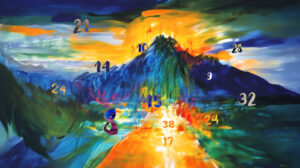Crumbling Foundations

A building should ultimately be judged not by its height or dimensions, but by its structural integrity
Over two millennia ago, a magnificent building stood on a mount in Judea. The building was impressive and splendid and admired by all.
All, that is, except for Chazal.
When Nevuchadnetzar destroyed the Beis Hamikdash and boasted that he had “bested” HaKadosh Baruch Hu, a voice said in response, “You have ground into flour that which was already flour” (Midrash Rabbah Shir Hashirim 3:4). Meaning, the Beis Hamikdash was already rotten and destroyed from within because of our sins; all that Nevuchadnetzar accomplished was to bring this state of spiritual decay into plain view.
This is an incredible description of a state of affairs whose reality was so different from its appearance. “Man sees with his eyes, while Hashem probes the heart” (I Shmuel 12:7).
In the last few months, Klal Yisrael has been centrally involved in three devastating structural crashes: on Lag B’omer in Meron, on Shavuos in Karlin, and right before Shivah Asar B’Tammuz in Surfside. Each of the many resulting petiros is an enormous tragedy beyond words. And the resulting horrific injuries and trauma are, of course, yet additional layers to the tragedies. This article intends to speak only to the experience of our tzibbur’s tragedy — as Klal Yisrael — and not to the individuals who were, Rachmana litzlan, directly involved in the disasters.
We do not know the “why” of these tragedies, nor is that the salient point. Rather, we need to internalize the “what.” That “what” is that no matter its appearance, a building should ultimately be judged not by its height or its dimensions, but by its structural integrity. For if a building is not sound, then not only is its height not impressive, but every additional story actually increases the danger of collapse, and the danger to its occupants.
The Mishnah (Avos 3:17) likens a person whose knowledge exceeds his deeds to a tree whose branches are more numerous than its roots. The baalei mussar explain that this does not mean merely that the roots cannot adequately support the tree. Rather, it means that the more branches there are, the more likely that the tree collapses! It is the lopsided ratio of branches to roots that causes disaster.
Eastern Europe in the 1800s looked religiously impressive. Mitzvah observance was the norm, communities obeyed their rabbanim, chassidish courts were booming, Volozhin was an incredible makom Torah, and there were many “kloizen,” small batei medrash where talmidei chachamim sat and learned Torah, without any formal yeshivah structure. A look at the face of it would bring a smile to any Torah Yid.
But there was a person who could see a bit closer “to the heart,” and he was greatly troubled. Reb Yisrael Salanter sensed that the foundations of European Jewry had crumbled, and nothing had been done to shore them up.
Most rabbanim of the era rebuked people for aveiros committed; Reb Yisrael, however, does not speak of specific aveiros. Instead he bemoans a lack of tangible yirah. In his famous letter about Elul, he points out the lack of emotional awe, and he in fact dedicated his life to try and rectify that. He understood that a hollowness had gnawed its way into the heart of Klal Yisrael, and unless that bedrock of yirah was greatly reinforced, it would all come crashing down.
Many rabbanim opposed him. They felt that an investment of time, money, and resources into reinforcing the foundations would come with the price of a shorter, less beautiful building. Reb Yisrael did not contest that argument per se, but he maintained his point: if you erect a tall building on foundations that can’t support it, you’re inviting destruction.
His point was not only about foundations. You can have a rock-hard foundation, but if you do not keep adding columns to provide additional foundation for each added floor, then you are simply moving the danger zone a bit higher up. This project, Reb Yisroel postulated, is the work of a lifetime.
Unfortunately, Reb Yisrael Salanter was proven right. He passed away in 1883. And by the time World War I was over, 35 years later, Europe’s Torah Yiddishkeit had crumbled. Yes, the Haskalah was to blame, secular Zionism was to blame, Socialism was to blame, World War I was to blame.
But the Mishnah in Avos (3:17) says otherwise. It says that if the roots are numerous enough, then all the winds cannot uproot the tree! If the tree was in fact uprooted, we need to ask ourselves why the roots weren’t up to the task. We have little control over the “winds” that buffet us; but we do have the ability to strengthen the roots.
In the last half-century or so, HaKadosh Baruch Hu has put up the edifice of the post-Holocaust Torah community with breakneck speed. When I was growing up in the ’50s and ’60s, the question was which Orthodox shul would be the next to go Conservative. In yeshivos the question was which kids would remain frum; the idea of a secular Jew becoming frum was almost unheard of. The number of people sitting in kollel in all of America back then could probably not fill the main beis medrash of a big yeshivah today.
And here we are. HaKadosh Baruch Hu wrought a miracle; big people invested incredible mesirus nefesh; and we rub our eyes in astonishment.
But Rav Yochanan (Gittin 55b) admonishes us concerning the Churban: “Fortunate is the person who is constantly apprehensive” (Mishlei 28:14). He points out some seemingly “minor” events — cracks on the walls here and there — that were the beginning of the end.
When we look at the incredible amount of limudei Torah, kein yirbu, and the magnificent batei medrash of today, we should be grateful to Hashem and feel admiration and appreciation of those who built Torah with such mesirus nefesh. But we should become apprehensive, as well. Here and there, there are cracks, unusual sounds, and tremors. Is that simply a flaking of paint? A creak of a well-worn — but structurally sound — floor? Or... is it something more troubling?
Several years ago, the Hebrew-language edition of Yated Neeman published excerpts of a conversation that had been conducted during Rav Shach’s lifetime, in which he expressed this sense of foreboding:
Russia once had a very strong Jewish community. There were strong lay leaders, schools, yeshivos. There were many talmidei chachamim and gedolim. Every shul had many shiurim in the morning and at night. You have no idea how a pre-World War I Jew looked, suffused with Torah and yiras Shamayim. What has happened? I am fearful… I remember sitting with my uncle Rav Isser Zalman, learning in a shtibel. I, on the second floor of a building. Jews, who until yesterday had prayed with us, had become our persecutors. They were there to persecute us for studying Torah. We had to jump from the second floor in order to escape.
Did you ever think, how did the Haskalah in Europe succeed in toppling so many households like a stack of cards? The Jews are such a stiff-necked people, yet they were devastated overnight! How did this happen?
I’ll tell you. There were indeed Jewish homes with Judaism; but it was a Judaism of habit, practice by rote. Jews who observed the mitzvos, but without a soul!
Yiddishkeit is so beautiful, so rich. The life of an observant Jew is a life of song, a song that is both pleasant and uplifting.
And yet this had become a Judaism of rote, with no sense of being uplifted, no Divine spirit. And these houses collapsed overnight. And we must begin the slow and painful process of reconstruction.
The more important question for us is, are we building our children with solidity? When we choose a yeshivah for our children, do we note only how “tall” they’ll grow in this or that place, or do we take a deeper look at how solid a Torah persona and foundation they will form? There is an expression in Yiddish that describes this concept: “a geboyter bochur” — literally, a “built-up young man.” It describes someone who wasn’t merely left to grow tall, but whose every floor was meticulously laid.
This is true not only of yiras Hashem and ahavas Hashem but of Torah learning itself. The crown of learning is the lomdus. At times, one feels that today’s yeshivah bochur has a solid command of the “facts on the ground,” and the lomdus is indeed the crown that rises atop his mastery of those facts. But sometimes a bochur will be very involved in lomdus even as his knowledge of the Gemara and Rishonim remains a bit vague. A learning experience of that nature may be very exciting and engrossing for the young man, but inevitably the hollowness gets to him, and the desire for learning evaporates.
When we speak of laying an appropriate foundation, we often make the common mistake of focusing on the young, cheder-age children. And sure enough these wonderful, angelic-looking children sing “Hashem is One” and recount beautiful sippurei tzaddikim. But the strongest bedrock cannot support tall buildings on its own, unless the foundation is extended through columns as the building is built up.
This means that at each stage of a person’s development, one must keep extending the foundations in a way that is appropriate for that age and child. The mussar must engage, inspire, and enlighten each according to his age and temperament.
There are many different yeshivos and approaches. It is our responsibility as parents to find the yeshivah appropriate for building those structural columns within our children.
There is one more factor in any discussion of structural strength, and that is corrosion. No matter how well-structured the building, corrosion is a process that starts at the very first moment of its construction, and it does not stop until everything has disintegrated. Yochanan was a Kohein Gadol for 80 years — at which age he became a tzeduki (Berachos 29a)!
How do we deal with corrosion? We can minimize it by building in areas not so susceptible to corrosion, and we can paint our structures and apply chemicals that will resist corrosion, but the process itself cannot be stopped. The only solution is to keep inserting new supports, knowing that the old ones will fade at some point. Similarly, Reb Yisrael Salanter did not aim his mussar only at yeshivah bochurim; he aimed it at fully grown talmidei chachamim and yirei Shamayim.
There are many different support systems for buildings. Each one is suitable for a different type of building, or a different environment; all are an equally valid way of accomplishing the same goal. Reb Yisrael had a very specific method to achieve “structural integrity.” Different branches of the mussar movement interpreted it somewhat differently. Chassidus offered a multitude of approaches in order to achieve the same goal. All are equally valid and are suited for specific personalities. The only thing unpardonable is neglect and apathy.
For as the Navi warned us, “Fortunate is the person who is ever apprehensive!”
(Originally featured in Mishpacha, Issue 869)
Oops! We could not locate your form.










